2014 NFL Draft: Johnny Manziel Scouting Report (GIF heavy)
I hate scouting Johnny Manziel.
It’s not that I hate him as a player, or especially him as a college player: I love watching Johnny Manziel play football. It’s exciting, unpredictable and a little magical.
But more than anyone else, evaluators can make the most of him with “coaches film” (or more appropriately “coaches’ film”).
It’s far too easy for even neutral scouts to read into the type of player that he is or the reason he makes so many exciting plays from outside of the pocket. Does he move to manipulate the defense? Does he move because he doesn’t anticipate receivers getting open? Does he move because he’s a one-read player? What about because he sees a gaping hole in the defense? What if it’s because, for all the explosive playmaking he embodies, he intuitively understands the importance of “success rate” and first downs?
To some extent, broadcast film (again, courteously provided by Draft Breakdown) can answer some or even most of those questions. But a number of them can’t really be discussed until evaluators get the full field of vision, so we fill it in with what we think we see—and what we think we see, we usually want to see.
I unfortunately was not able to get my hands on that “coaches film,” like I have for a few other prospects, so for the most context-dependent player in the draft, I’ll provide some contextless analysis. And because of that, it will be even longer than the previous report (nearly 5000 words).
Like in the last scouting report (on Teddy Bridgewater), I’ll be using these categories to evaluate quarterbacks: Accuracy, Delivery, Pocket Presence, Ball Velocity, Field Sense, Scrambling/Running, Intangibles and Primary Concerns.
Accuracy: An ongoing debate regarding Manziel’s accuracy has to do not with his ability to get the ball to receivers, but placement to best protect receivers, enable yards-after-the-catch and prevent turnovers. In particular, the argument is that his “reliance” on Mike Evans inflates his ability on film. It’s an intuitively odd claim, given that Evans caught 69 of Manziel’s 300 completions, but it’s not a claim completely without merit and many of his throws to Evans are put in unusual spots.
His relationship to Mike Evans as a receiver is overblown. If he can put the ball where only his receiver can get it, he should. It’s true that his throws to Mike Evans often don’t make sense within context and it’s a worry, but I think his passes to other receivers can provide a good glimpse into who he is as a passer.
Receivers often have to leap when they shouldn’t need to. Screens are limited by errant ball placement. Players running crossing routes have to reach behind themselves in order to get to the ball. Many times, it IS true, his receivers save him from ball placement that should “rightfully” be interceptions.
His proponents will argue that his interception rate should be lower than it is (officially 3.0%) because many of his interceptions come from balls batted by his receivers. This is accurate insofar as there are a number of interceptions that come from tipped balls, but not necessarily accurate in terms of what it means:
Poor ball placement (high and behind the receiver) is a big reason for incomplete and tipped passes, and it would be dishonest to argue that Manziel wasn’t mostly responsible for that interception even if the ball hit the receiver in the hands.
Manziel has clear talent in every dimension of accuracy, whether it’s basically getting to the ball to his receivers, finding space for his receivers, throwing on the run (which it should be noted, is one of the most consistent and impressive parts of his game), etc. but does not show it with the frequency and repeatability that an NFL scout should want in a first-round pick.
He certainly has a gift for ball placement, especially on deep passes, but his exceedingly precise and accurate passes are interrupted by long streams of baffling ball placement and poor general accuracy. The amount of throws that show this precision are too numerous to dismiss, so it’s clear that this is a repeatable skill that he has well worth consideration:
His distance-specific accuracy is a big concern, too. If you remember the passing charts from a few weeks ago, Manziel’s accuracy is worrisome between 5 and 14 yards. For the most part, this seems to accord well with the other charts I’ve looked at and is in part due to his issues that will translate poorly to timing-oriented offenses.
50% of the passes in NFL Air Coryell offenses are between 5 and 14 yards.
He simply isn’t an anticipation thrower, and that will really limit the types of offenses he can play in. He rarely throws receivers open, instead throwing the ball at players who are already open. There are some NFL offenses where this can work, but they become rarer by the year, and certainly not the type of offense that Norv Turner has run historically.
I like his ability to throw on the run, left or right, and I think this is one of the reasons his arm strength is underrated. He’s generally more accurate than his peers when he’s on the move and this should be an asset for him as he develops into an NFL offense, regardless of how much (or how little) they want him to conform to a system—rolling him out should work well.
Delivery: Much has been made of Manziel’s improvement in terms of his mechanics and throwing motion, and I think that a lot of it overshadows a simple truth: he still has a long way to go. To choose an admittedly extreme example:
Which isn’t to say that’s representative. Look at this play (it’s the very next one) and ignore the result (perhaps Sunseri’s hold threw off the timing significantly):
Those are pretty good mechanics. He transfers his weight, generates torque, drives through with his hips and lets his body guide the ball. But too often, you see this:
In general, his mechanical improvements are ongoing, and nowhere near complete. When he’s not concentrating on his mechanics, the throw moves his body instead of the other way around, which creates velocity problems as well as accuracy issues. I noticed that over the course of the season, his mechanics improved in their consistency and general principles, but would still degrade very quickly over the course of a game.
It’s an interesting case study for talent vs. technique.
Manziel’s release is a bit longer than I’d like in terms of length of throw, but not really in timing. He cocks his arm back quite a ways but moves it quickly enough not to concern me too much. In terms of improvising his throws to fit the situation, Manziel grades out a little lower than I expected.
He shows 3/4 motion, over-the-top delivery, sidearm throws and the like at different times, but sometimes they are not context appropriate, while at other times they are. I don’t think this really qualifies him as the type of player who delivers the ball from multiple platforms, but he certainly can be that type of player for sure.
I’m worried about his footwork dropping back. It looks like he generally hasn’t been coached there, and the fact that his system includes no urgency or timing elements to any degree makes me think the transition will be extremely tough. On the other hand, when playing from under center and handing off on a play fake, he looks like the model quarterback.
Pocket Presence: Contrary to the prevailing opinion on Johnny Manziel, I really don’t think he has particularly good pocket presence. In this context, I mean the set of skills as a passer to properly stay in control during a muddy or threatened pocket.
His mechanics degrade under pressure, and not just when he’s throwing on the run or scrambling; staying in the pocket and heaving the ball against interior pressure causes his front leg to lock and his passes to sail.
I don’t particularly think his ability to sense pressure should be as lauded as it is, and he’ll scramble towards pressure instead of away from it more often than makes me feel comfortable. Again, I should temper it by saying that there are too many instances to discount of him eluding pressure that seem magical, as if he were imbued with RADAR instead of eyes.
So, does Johnny have a great instinct for sensing pressure? Probably. But he clearly overreacts.
On the other hand, there’s this:
This seems to be a good time to talk about Process vs. Outcome. At a fundamental level, people understand the divide between evaluating a process and evaluating an outcome. From a football perspective, it’s easy to find examples everywhere. The most obvious example, of course, is measuring quarterbacks (or coaches) by wins instead of anything else.
A lot of other measures of quarterbacks can come to different conclusions, and process-oriented measures, like net yards per attempt (which is in itself an outcome-dependent measure, but it gets complicated when we talk about second-order outcomes and whatnot so for now this example will do), do a significantly better job predicting future outcomes than past outcomes. In fact, net yards per attempt is a far, far better predictor of future winning than past wins—which is honestly terrible at predicting future wins.
Despite all that, it’s very easy to get caught up in accomplishment. It Might Be Dangerous, a blog about baseball, talks about this when it comes to draft analysis (in a different way), and to open the discussion (as many process v. outcome discussions do), the author talked about gambling:
Many years ago I was playing blackjack in Las Vegas on a Saturday night in a packed casino. I was sitting at third base, and the player who was at first base was playing horribly. He was definitely taking advantage of the free drinks, and it seemed as though every twenty minutes he was dipping into his pocket for more cash.
On one particular hand the player was dealt 17 with his first two cards. The dealer was set to deal the next set of cards and passed right over the player until he stopped her, saying: “Dealer, I want a hit!” She paused, almost feeling sorry for him, and said, “Sir, are you sure?” He said yes, and the dealer dealt the card. Sure enough, it was a four.
The place went crazy, high fives all around, everybody hootin’ and hollerin’, and you know what the dealer said? The dealer looked at the player, and with total sincerity, said: “Nice hit.”
I thought, “Nice hit? Maybe it was a nice hit for the casino, but it was a terrible hit for the player! The decision isn’t justified just because it worked.”
. . .
As tough as a good process/bad outcome combination is, nothing compares to the bottom left: bad process/good outcome. This is the wolf in sheep’s clothing that allows for one-time success but almost always cripples any chance of sustained success – the player hitting on 17 and getting a four. Here’s the rub: it’s incredibly difficult to look in the mirror after a victory, any victory, and admit that you were lucky. If you fail to make that admission, however, the bad process will continue and the good outcome that occurred once will elude you in the future. Quite frankly, this is one of the things that makes Billy Beane as good as he is. He is quick to notice good luck embedded in a good outcome, and he refuses to pat himself on the back for it.
. . .
Championship teams will occasionally have a bad process and a good outcome. Championship organizations, however, reside exclusively in the upper half of the matrix. Some years it may be on the right-hand side, most years should be on the left. The upper left is where the Atlanta Braves lived for 14 years – possibly the most under appreciated accomplishment by a professional sports organization in our lifetimes. In short, we want to be a Championship organization that results in many Championship teams.
Interestingly, Barry Ritholtz of a wealth management firm uses the example of an NFL team that has prioritized process over outcome at the behest of their head coach, Tom Coughlin. Ritholtz goes on to argue that this process-oriented focus has led to long-term gains for Coughlin, and is a lesson that can be applied to investing.
Generally speaking, good processes will lead to good outcomes in the long-term. A short-term focus on outcomes is itself a bad process, lends itself to high variability and can cause some serious problems.
With all that in mind, let’s look at that incredible play from a process perspective:
Immediately, at the end of his drop, two of Manziel’s receivers are open, the inside receiver for an enormous gain with nothing but green ahead of him. He scans that side of the field and sees nothing worth throwing, well before pressure appears. He cocks back his arm, hesitates and brings the ball back down. He continues to scan the field and begins to abandon the pocket well before pressure arrives. While understandably something that could (should) cause concern, it’s not real pressure and if it was could be avoided by sidestepping instead of a looping scramble. And if we’re completely honest, that was a 50/50 ball at best.
But that is a bit harsh.
Alternatively, Manziel’s likely progression is outside in, and his outside receiver was well covered on the play before he could move on to the next receiver in the progression. Manziel senses pressure—a trait that his proponents argue is preternatural (and I understand this)—and begins to escape it before it can do harm in a way that kills pass-rushing angles. That his offensive line picked it up is a happenstance, and Manziel is smart enough not to take that as fait accompli. Pressure given up by the left tackle is not his fault and he proceeds to make magic.
Even a theoretically superior, process-oriented approach can reveal the biases of the evaluator. Personally, I think the first explanation of the play is more accurate.
In this case, process stands opposed to outcome and presents some serious concerns about his play at the next level. That, naturally, forces us to ask why the outcomes were so favorable so consistently if the process was so flawed, but I think that question presumes that outcomes come from similar techniques in college and the NFL. With the (relatively) low level of quarterback play needed to be successful in college, I think there is a right to assume that successful outcomes in college do not translate to successful outcomes in the NFL if the processes are different.
There are many instances of objectively good pocket presence as well, like the following:
But for the most part, Manziel reacts too early to pressure, or to pressure that doesn’t exist. Having looked at nearly every single scramble and sack over the course of seven games at least three times, I’m supremely confident in this assessment.
Manziel sees ghosts.
It happens with both edge pressure and interior pressure, but is worse with interior pressure. Reacting far too much (and far too early), he spins back to avoid the pressure and turns his back to the field, losing any vision he had. This rarely works in the NFL, particularly with how wide his loops are (and therefore how long he misses seeing the field).
Sometimes, even if he doesn’t scramble in response to pressure, he’ll kill his technique in order to get rid of the ball:
Integrating his skills is a tough issue for him, because in that clip he does a lot of things I have criticized him for not being able to do: read a defense, anticipate a receiver and stand in the pocket in response to pressure. But with room to step up, he leans back, pushes backwards on his front foot and leaps off the ground to make the throw, which ended up being ruled incomplete.
The issue of his scrambling is a contentious one, and his proponents will argue that he moves in order to shift the defense. It’s a valid strategy, especially because defenders are asked to cut off running lanes, which really strains their abilities to maintain their spot drops and sound coverage.
This is one of the primary issues that reveals the intentions of the evaluator, to be completely honest. When he scrambles without pressure, some folks are happier to argue that it was a way to move defenders around and to get people open.
In the limited sample size of scrambles where I get to see the entire field, that is not the case, and primarily because he’s not an anticipation thrower.
Ball Velocity: Another tough nut to crack. Manziel displays very poor arm strength on deep throws, even when he has fairly good mechanics. The ball arcs high, comes in slow and flutters. On the other hand, he makes some extremely difficult throws when his body is in the worst possible position to throw and flings it, implying that he has some extremely underrated talent in his arm.
I think part of this is him adapting to the new mechanics he had to drill with George Whitfield, Jr. and how unnatural it still is to him. Over the course of the season, he threw with better mechanics more consistently, though it became clear that they could go away if rattled.
The difference between “raw arm strength” and “functional arm strength” is fairly large for him, and is the reason his balls flag at the end of long passes or arc instead of move forward. There are times when his natural arm strength saves him, but more often than not his passes move slowly and could present serious problems in terms of turnovers and scheme limitation in the NFL.
His arm strength on intermediate distance passes is good, and those balls don’t tend to arc unless they’re a late read (wholly excusable) or under pressure (variable excusability).
I don’t think Manziel has a particular talent for touch, but I don’t think it’s a concern, either. Ball placement consistency concerns aside, he does throw a catchable ball.
Field Sense: The debate over his ability to read defenses is secondary to his ability to find open receivers. He regularly glosses over open receivers through his reads and only tends to make one of them before making a decision. There are definitely times he goes through a progression, but they are rarer than I’d like.
When he scrambles, he rarely keeps his eyes up in order to read the field and make a second throw (but that’s not to say he doesn’t do it). At times, when he does make it to his second read, he’ll throw to a player who isn’t open. But sometimes, he has a good intuition, seemingly, for what’s about to happen:
Yes, he leaves the pocket too early and scrambles the wrong way, but he does keep his eyes up and goes through a number of options before an incredibly impressive pass to Labhart.
Here, he goes through at least two reads, but seems to miss an open out route and open crossing route:
The crossing route does not open particularly late or anything, but even if it did, the anticipation to throw to a spot before the receiver gets open is an enormous part of the NFL games as a quarterback, some very specific systems aside.
Aside: While I was putting the finishing touches on this article, @itsyoboyos tweeted at me to tell me that Manziel can’t throw a crossing route over the middle of the field. I haven’t tracked it thoroughly, so I can’t say that he hasn’t thrown any in the games I’ve watched, but it’s extremely rare for him to hit those passes, even when wide open. This comes from his inability to throw the ball with anticipation.
To his credit, he makes decisions quickly and commits to them, which doesn’t get discussed enough for a prospect. Many quarterbacks in this class don’t have that quick ability to make decisions without hesitation, and it’s the sort of thing that dooms NFL signal-callers.
As for his responsibilities at the line, Airraid quarterbacks typically are given a lot of ability to make calls at the line of scrimmage in terms of plays, though as far as I know do not have the multiple, layered responsibilities of many “pro style” quarterbacks. For example, most Airraid offenses seem to have 60 different plays, but really have more like 5 or 6 with a bunch of different formations. Memorizing and calling out of an NFL playbook is far different when there are a multitude of plays and a multitude of formations. Tagging the formation, then the play, is a much easier mental load (by several degrees).
With all that in mind, it is good that Manziel has control of the offense, but not close to the amount an ideal prospect would.
It is important that he be able to read defenses, and it’s pretty obvious Manziel has the basic keys down and can adjust to them easily. The more complicated defensive reads and keys I don’t think he has down, and much of that has to do with his simplified offense more than his ability.
In 2011, I argued that Cam Newton’s primary concern was not an inability to read defenses, but a gray area in regards to whether or not he can. It turns out that he can, which is nice. Manziel is in a similar (but not identical) spot. I think that Manziel has proven he can read what he needs to read (which wasn’t a lot, but more than Newton) and adjust the offense for it, and I’ll be intrigued at what happens with his speed at reading defenses at the next level when his reads grow more complex along with his offense.
Scrambling/Running: This is the easiest thing to write about. Manziel is a superhuman runner and scrambler. It’s not just his athletic ability—talent that isn’t fairly represented by his 40 time (a quick-ish 4.68), but can be better captured by his three-cone and shuttle times (6.75 and 4.03).
His instincts for running are second to none, and Matt Waldman made the point that his playing style could best be compared to Muhammad Ali. While I don’t agree with his larger take on Manziel (which, in all honesty, makes me question my analysis more than anything else), this is a fantastic metaphor and applies best to his running style. If you have time, take a look at the Bloody Elbow’s analysis of Muhammad Ali and the Anchor Punch.
Waldman made the point earlier about Manziel’s effective unorthodox style and compared it to Ali, but the specific point here I want to make is Manziel’s gift for feints, head fakes and enabling overpursuit in order to gain yardage.
He sinks his hips like a running back and he has excellent efficiency in his movements, with short but smooth strides that make it difficult to gauge his direction while giving him added latitude to respond to the field.
As a running quarterback, his vision is superlative and he has the patience to watch his blocks develop before committing (an odd trait to identify in such an otherwise impulsive quarterback) and is one of the best pure runners in the draft.
That’s as impressive a designed run as any.
I don’t think his running style is an injury concern; he avoids hits and probably takes fewer tough shots from big guys than most pocket passers.
Intangibles: There are a number of any essays one can write about Johnny Manziel’s “intangibles,” and again I would like to emphasize that “intangibles” and “off-field concerns” are not the same thing (no matter how correlated they may end up being). As a leader on the field and a player willing to set an example to teammates, Manziel checks out.
There’s no questioning his fiery competitiveness, and it’s clear that his desire to win trumps any other desires that might affect his play on the football field. I don’t think that Manziel will have any trouble inspiring teammates or, through his presence on the field, encourage good play.
Manziel is legitimately concerning in regards to how willing he is to apply himself in the film room or engage in the type of post-game review that allows players to get better, but it is difficult for me to speak on this aside from rumors I’ve heard.
On the other hand, Mr. Football also did a lot of work in the offseason to improve his mechanics and engaged in a lot of mentally and physically strenuous work in order to maximize his talent as a player and draft prospect. I ultimately suspect that Manziel’s competitive nature will ultimately drive him to engage in some of the hard work necessary to become an elite quarterback, but I worry about his ability to digest film.
Primary Concerns: For the most part, I think it’s relatively fair to wash out a lot of the LSU and Missouri games because of his injury, but not eliminate them. If we are to laud quarterbacks like Derek Carr for playing an entire season with an abdominal tear or Bridgewater for eviscerating Rutgers with a broken wrist and a hobbled ankle, we should at least downgrade Manziel in relative terms for having such a big dropoff due to injury.
What I don’t particularly like and don’t see a lot of talk of about Manziel is his maddening inconsistency. His Alabama game this year functionally had 60 actionable plays to evaluate, and it would have been easy to split them into 30 bins of plays, where the first group of plays would make him look like a superstar and the other 30 would make him look like a late-round project at best. I don’t feel this is true for any other quarterback, at least over the course of one game.
Because I haven’t seen other people mention it (particularly those whose evaluations I hold in very high esteem), I don’t want to make too big a deal of it, but it’s a big part of the reason I don’t want to simply take him and project his high points as his true talent level while ignoring his low points. This has nothing to do with his playing style or the questions he seems to draw about Mike Evans, this was something people saw out of players like Blaine Gabbert but not from players like Russell Wilson (and to use a contemporary example of an inconsistent player, Aaron Murray—who I have not really broken down enough to have a strong opinion of yet).
As for Manziel’s height—a criticism we are seeing less and less of—I think there are real concerns for a generic quarterback prospect, but not for him. The key to a player with suboptimal height, like Russell Wilson or Drew Brees, is how they handle it—not automatically downgrading it. Both Wilson and Brees are experts at sliding and finding open throwing lanes; they can adapt to the height issue. For the most part, I can see this of Manziel, too.
In regards to his off-field concerns, I think they’re real but they impact traditional NFL decisionmakers much more than they worry me. I still think he has to answer questions about his time at the Manning Passing Academy, but the controversy surrounding the autographs he signed or his brashness about it do not worry me.
His willingness to party hard and late seems to be a bit overblown, but I do think it’s another issue he has to address. For the most part, I don’t think this impacted him during spring football, the college preseason or the actual season. If I’m right about that, I don’t really care what he does in his off time. NFL traditionalists do, however, and that may unfairly drop him. If I’m wrong, it’s a serious character flag that I think needs to be addressed.
Conclusion: Normally an inconsistent quarterback would drop quite a few rounds (think Mike Glennon), but that usually means vacillating between “bad” and “good.” Manziel’s ability moves between “bad” and “one of the best” and his ability as a player with high potential shouldn’t be ignored. Manziel has a ton of talents, but I don’t think they’re integrated and I think it’s a bad gamble to assume they automatically will be.
In terms of a “true grade” think this drops him by more than a round, but no quarterback should or will be graded that way. In terms of his prospects compared to other quarterbacks and where they’ve been drafted, he’s a little bit better than the preponderance of second-rounders as a potential draftee. To me, that makes him a high second-round guy who has the type of talent that makes sense to take in the late first.
The gap between him and other top incoming rookies (Andrew Luck, Teddy Bridgewater, Robert Griffin III, etc.) is very large, but that means less at quarterback than it does at other positions because of how they get pushed up boards (consciously or unconsciously).

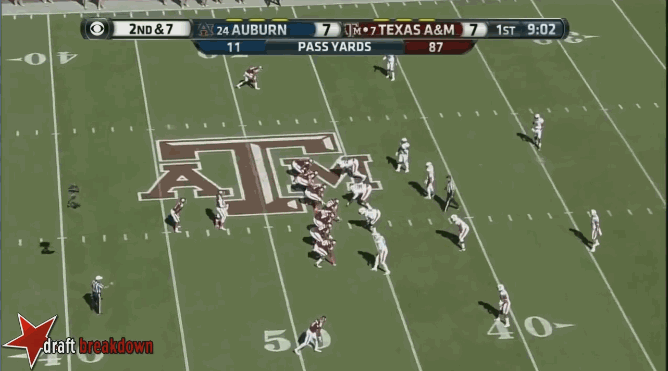
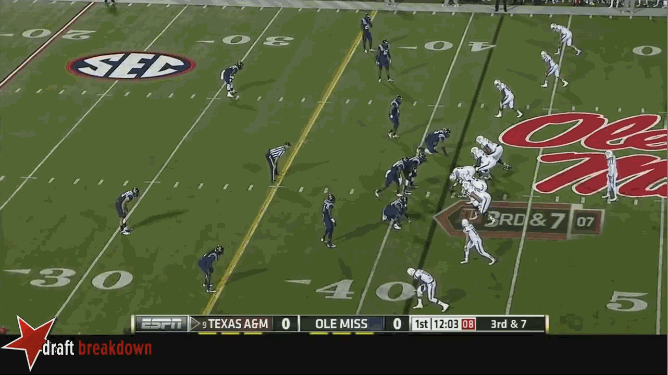
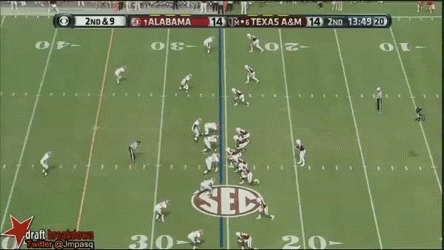

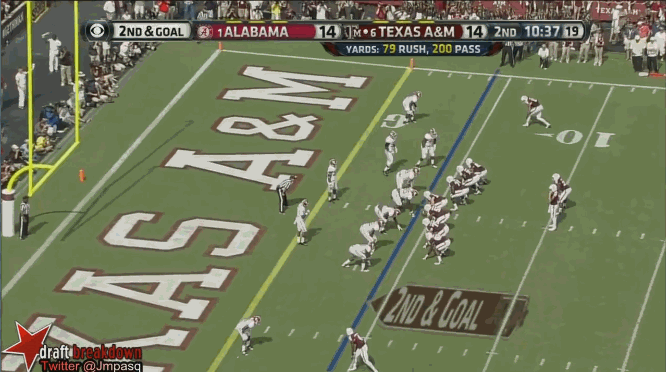
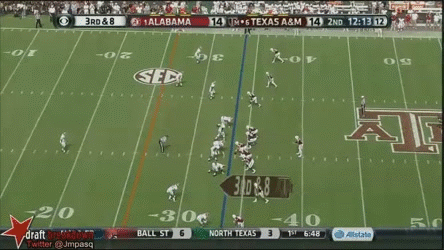

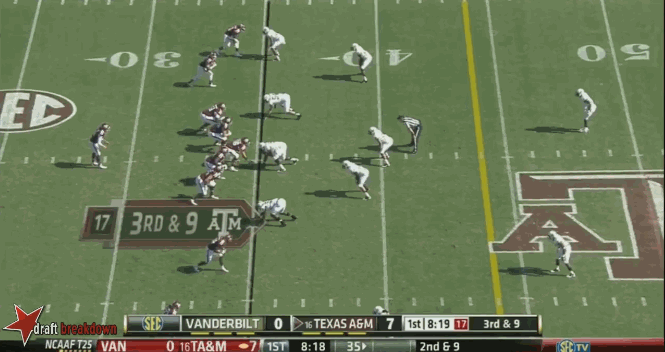
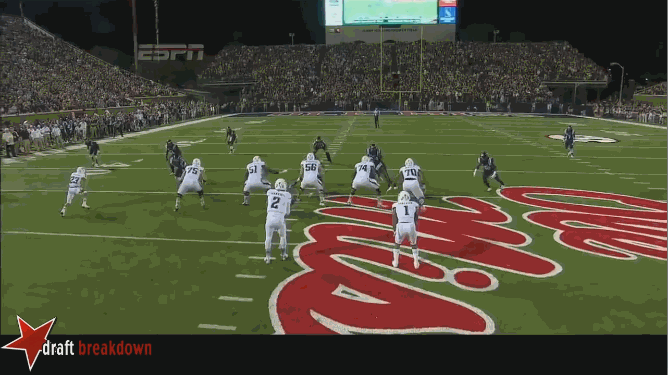
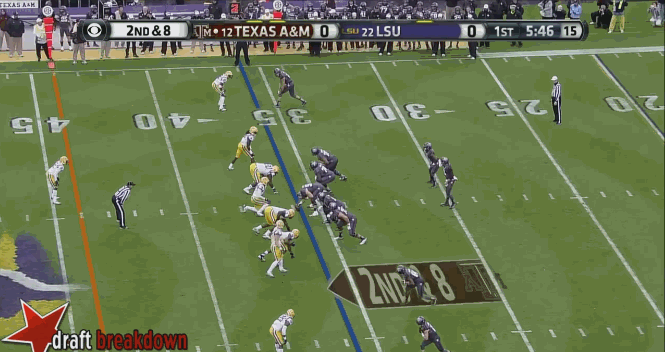
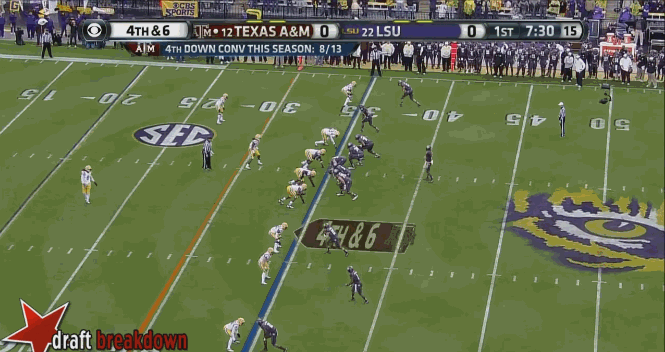

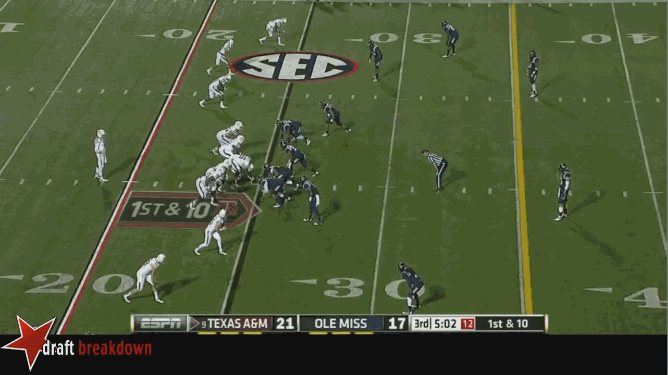


You must be logged in to post a comment.